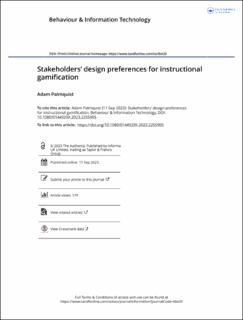| dc.contributor.author | Palmquist, Adam | |
| dc.date.accessioned | 2023-11-01T07:25:13Z | |
| dc.date.available | 2023-11-01T07:25:13Z | |
| dc.date.created | 2023-09-22T13:36:22Z | |
| dc.date.issued | 2023 | |
| dc.identifier.citation | Palmquist, A. (2023). Stakeholders’ design preferences for instructional gamification. Behaviour and Information Technology. doi: | en_US |
| dc.identifier.issn | 1362-3001 | |
| dc.identifier.uri | https://hdl.handle.net/11250/3099878 | |
| dc.description.abstract | There is increasing interest in incorporating game design elements in workplace learning, known as instructional gamification. Despite initial positive indications, there is still a need for a deeper understanding of how organisational stakeholders play a role in implementing instructional gamification. This study employed an explanatory sequential mixed-methods approach to identify and understand stakeholders’ instructional gamification design preferences and how these preferences might impact their endorsement of instructional gamification. A survey of 231 individuals at a software company was conducted to gather data on stakeholders’ preferences for instructional gamification. This was followed by in-depth interviews with eight employees to further enhance the understanding of stakeholders’ instructional gamification design preferences. The quantitative findings revealed four interrelated factors concerning the instructional gamification design preferences of the three stakeholder groups. However, the qualitative findings revealed that the stakeholder groups interpreted the items differently. By integrating the quantitative and qualitative findings, the study provides a comprehensive understanding of the factors that enable or hinder stakeholders’ endorsement of instructional gamification in workplace learning. The study also presents four design propositions that facilitate stakeholder endorsement of gamified learning artifacts. The findings have both theoretical and practical implications for designing and implementing instructional gamification in workplace learning environments. | en_US |
| dc.language.iso | eng | en_US |
| dc.publisher | Taylor & Francis | en_US |
| dc.rights | Navngivelse 4.0 Internasjonal | * |
| dc.rights.uri | http://creativecommons.org/licenses/by/4.0/deed.no | * |
| dc.subject | Arbeidsplasslæring | en_US |
| dc.subject | Workplace learning | en_US |
| dc.subject | Faktoranalyse | en_US |
| dc.subject | Factor Analysis | en_US |
| dc.subject | Work place learning | en_US |
| dc.subject | Workplace learning | en_US |
| dc.subject | Kombinasjonsstudie | en_US |
| dc.subject | Mixed methods | en_US |
| dc.subject | Design av informasjonssystemer | en_US |
| dc.subject | Design of information systems | en_US |
| dc.subject | Teknologi og design | en_US |
| dc.subject | Design & Technology | en_US |
| dc.title | Stakeholders’ design preferences for instructional gamification | en_US |
| dc.type | Peer reviewed | en_US |
| dc.type | Journal article | en_US |
| dc.description.version | publishedVersion | en_US |
| dc.rights.holder | © 2023 The Author | en_US |
| dc.subject.nsi | VDP::Systemutvikling og -arbeid: 426 | en_US |
| dc.subject.nsi | VDP::System development and design: 426 | en_US |
| dc.subject.nsi | VDP::Systemutvikling og -arbeid: 426 | en_US |
| dc.subject.nsi | VDP::System development and design: 426 | en_US |
| dc.subject.nsi | VDP::Systemutvikling og -arbeid: 426 | en_US |
| dc.subject.nsi | VDP::System development and design: 426 | en_US |
| dc.source.pagenumber | 33 | en_US |
| dc.source.journal | Behaviour and Information Technology | en_US |
| dc.identifier.doi | 10.1080/0144929X.2023.2255905 | |
| dc.identifier.cristin | 2177960 | |

